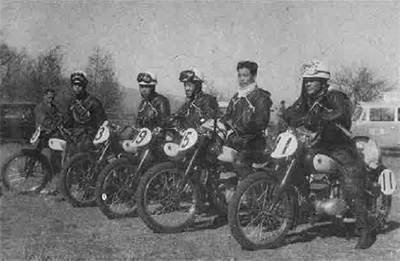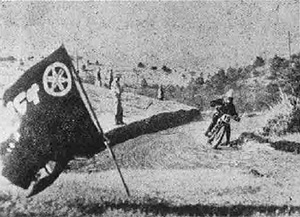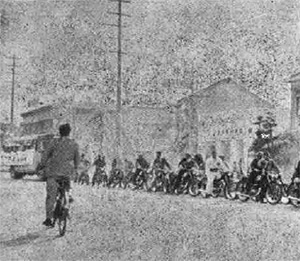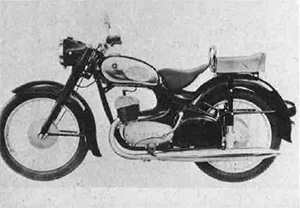What the Japanese Bayberry Trees Have Seen Stories from the Early Years of Yamaha Motor
37The Asama Highlands Race
On September 18th, 1955, six machines were sent off to practice for the Asama Highlands Race. The next day, the three riders that would contest the race, Shigeru Konagaya, Teruo Okada and Noboru Hiyoshi, set off ahead of everybody led by Department Manager Murakami.
The Asama Highlands Race’s official name was the “1st All Japan Autobike Endurance Road Race,” and it was conducted with the aim of improving the performance of Japanese motorcycles. As such, it was sponsored by the Motorcycle Racing Federation of Japan with support from the ministries of International Trade and Industry, Transport, Construction, and Foreign Affairs, the Nagano and Gunma prefectural governments, and the Society of Automotive Engineers of Japan.
Yamaha could enter the Ultra-lightweight class race (up to 125cc), but there were three other race classes as well (Lightweight, Junior and Senior). After such a dominant showing at the Mt. Fuji Ascent Race, we had to bear the burden of expectation that we would definitely win at Asama as well, despite Yamaha still being a newcomer to the motorcycle industry. As work on developing engines for racing progressed at the R&D center at the Hachiman Warehouse, preparations on the ground at Asama were moving forward at a steady pace. The team manager was one of the top salesmen of the Aka-tombo (“Red Dragonfly”)—Zenzaburo Watase. He’s currently the Managing Executive Officer at Yamaha Gamagori Works (in 1978).
Immediately after the Mt. Fuji Ascent Race, Honda established living quarters in the Asama Highlands and in the town of Karuizawa, and had already begun intensive training and testing. Upon learning of this, Watase began secretly searching for an inn to rent in the area to set up Yamaha’s own base of operations and eventually found one at Asama Yokoen.
 The Asama Yokoen inn
The Asama Yokoen innWhen renting the property he pretended to represent a color film company. After the deal was signed, Watase later confessed to the owner that he had lied to keep the true nature of their work a secret, and the two shook hands and agreed to keep the whole thing confidential. Truly, this was Watase at his best!
The 1st Asama Highlands Race was held on public roads; the course started from Kita-Karuizawa sports ground, then ran uphill to the entrance to Asama Farms where it turned left and crossed Kuromame Riverbed. Then, after passing Mine No Chaya (the teahouse at the peak of Mt. Asama) and going through Onioshidashi, the course returned to the finish line at Kita-Karuizawa. One lap around the course was about 19.2 km. The roads were very rough, strewn with volcanic rock and kicked up big clouds of dust. Today, it’s hard to even imagine racing motorcycles over public roads like that.
Because Yamaha’s lodging bordered the course, it was quite useful for clocking the times and gauging the performance of the competition. Since teams from all the manufacturers had gathered to practice on the race course, there was all manner of plotting, diversion strategies and spying to try and figure out what the competition was up to. The usually quiet and peaceful Kita-Karuizawa—known as an escape from the scorching summer heat of the big city—was transformed into a veritable den of Asura, the Buddhist fighting demons!
Even when contacting headquarters, there was a lot of energy spent on keeping everything secret at all times. To conceal the Yamaha name, we couldn’t make casual telephone calls or mail letters, and because Kita-Karuizawa was such a small town, there was no telling where information could be leaked or who was contacting whom. Needless to say, the team was operating under very high levels of stress!
After the race team arrived, Yamaha’s testing and practicing kicked into high gear, giving the other teams plenty to worry about. The practice schedule was as follows: wake up at 4:00 in the morning, a light breakfast of milk and two raw eggs, then calisthenics followed by practice rides. By the time the other teams had woken up, Yamaha’s morning practice session was over. Practice started again at around 3:00 in the afternoon.
Our strategy to get the jump on our rivals was very rational and we had excellent teamwork, allowing the riders and mechanics to effectively polish their skills.
38On Call as Factory Backup
As practice for the race intensified at Asama, the racing support group at headquarters was bombarded with increasingly demanding requests from the team for backup.
As I wrote earlier, because the bikes were basically being ridden hard on very rough roads littered with volcanic rock, the frame pipes became bent out of shape and we had a lot of trouble coming up with a solution—and this was just the first of our problems. We would build new frames and other parts to deal with the issue and quickly send them off to Asama and the team for immediate testing. We did this over and over without delay because these efforts would heavily influence whether we would win again or be defeated.
On October 28th, we sent five chassis for race day to Asama, followed the next day by the final five. Two different types of engine were used: those built and tuned by Ono-san or Nakatani-san, both using innovative ideas from the two of them. Even with the race just around the corner, supplying tires to the team was still an enormous task and we had fuel tanks leaking around the petcocks so 12 tanks with a new design had to be hurriedly constructed and shipped off. They arrived just three days before the race. The work was non-stop.
It was in the middle of the night on November 2nd—rather, it was 12:30 in the morning of November 3rd, the national holiday of Culture Day—when an emergency call came in from Asama. I was standing by at the factory in case anything happened and that was when I picked up the phone. Most of company management was at Asama and they were in the middle of a noisy meeting about fixing a problem with the machines’ performance.
What they said was, “Because the engines are susceptible to change, the atmospheric pressure and weather are hampering performance. We have four engines at the R&D center at Hachiman Warehouse and three more new engines at the factory. We need you to send them as quickly as possible. We know it’s the middle of the night but there’s really not much time left, so please go to the hospital right now and get the president’s permission to send the engines. Then put them in the president’s car and have Tamaki-san (the president’s personal driver) get them up to us.”
So, I went straight to President Kawakami at Nippon Gakki’s clinic at 2:00 in the morning. Needless to say, he was surprised to be awakened in the middle of the night and wondered what had happened, but as soon as he heard me out he immediately gave his permission to send the car. It bothered me to have caused the president this worry but we had no time to waste.
I immediately called Tamaki-san then ran off to find the engines at the warehouse in Hachiman. But because the R&D center was for top-secret work, even I wasn’t allowed in so I had no idea where anything was located. After searching around with a flashlight for what seemed like ages, I eventually found the engines we were looking for.
By 4:00 a.m. Tamaki-san and I had loaded the seven engines into the car and he was out of the main gate at Nippon Gakki and headed for Asama at full speed! I kept thinking that this was just like the last-minute panic we went through to ship a batch of engines before racing at Fuji. Fully believing we could pull off a win again, as the rear lights of the Toyopet Crown receded into the distance and the eastern sky began to lighten, I prayed with all my heart that our frantic efforts would be rewarded with victory a second time.
39Victory at Asama!
 Riders await the start of the race
Riders await the start of the raceEveryone at Asama worked feverishly through the night before the race to ensure that the machines would be race-ready.
The race started at 9:00 in the morning with the Lightweight class. Two riders left the starting line every 30 seconds. The Yamahas entered in the Ultra-lightweight class would make four laps of the 19.2 km course. The 28 machines competing in the class from eight different manufacturers began to take off in pairs from the line at 1:30 that afternoon.
In the free practice session the day before the race, Masuko had crashed and suffered a pelvic fracture. Fortunately, we had Dr. Goto there from the factory—he was nicknamed “Dr. Garlic”—and he was able to treat Masuko.
November is deep autumn in the Asama Highlands; the earth is coated with frost in the morning and it’s quite chilly even during the day. And it was under a deep blue autumn sky that the machines from each manufacturer fought for glory through the mountains. Since the riders were individually timed, there was no way for the spectators lining the course to know who was leading.
 A Yamaha races through the highlands
A Yamaha races through the highlandsSounding like giant horseflies, Yamaha’s 125cc 2-strokes left a metallic sounding exhaust note in their wake as they screamed around the course at high speed, the pampas grass swaying as they sped by.
All the Yamahas successfully completed the first three laps, but then Taneharu Noguchi, who had been clocking the fastest times of all our riders, was forced to retire with engine trouble. It was a tremendous disappointment for everybody.
 The winning Yamaha crosses the finish line
The winning Yamaha crosses the finish lineWhen the long and hard-fought race came to an end, Yamaha had once again dominated the competition, and the team basked in the well-earned glory. Taking the win was Noboru Hiyoshi, with Shigeru Konagaya finishing 2nd and Osamu Mochizuki in 3rd—all on Yamahas. All the riders had exchanged the white riding suits they’d worn at Fuji for black racing leathers with white helmets. They all looked very cool and justifiably proud as they stood on the podium.
The many supporters from Nippon Gakki’s Tokyo branch and the numerous dealers from across Japan hugged each other in jubilation at the decisive Yamaha victory. The good news reached me that evening at headquarters and I immediately went to the clinic to inform President Kawakami of our great success; the news pleased him immensely.
Thinking back, no sooner had we won the Mt. Fuji Ascent Race than the president began taking the many steps that ensured our success at Asama. His strategy was right on target and we were all able to bask in the resulting success, so I imagine he was overjoyed at having realized his great ambition.
The company had won two of Japan’s major motorcycle races only a few short months after its founding. This shot us to fame and our small company that was producing at best 300 machines per month was even being treated like a major player in the industry. This really drove home the power and significance of racing in my mind.
 The victory parade in Hamamatsu
The victory parade in HamamatsuOn November 7th, the Yamaha team made a triumphant return to Hamamatsu. As part of the celebration, a parade of fifty Yamaha motorcycles rode from Hamamatsu Station through the city streets to the main gate at Nippon Gakki. That evening, the president held a big party at the Seifuso company inn at Nippon Gakki to celebrate the win at Asama.
The race win gave a big motivational boost to our sales department. The race-winning machines were taken and displayed around the country and we worked hard to advertise and promote sales. Yet in spite of these efforts, sales remained stagnant and we began to realize that selling 200 units per month was our limit.
40The YC-1 Debuts
It soon became clear to us that for the company to stay afloat, we needed more than just the 125cc YA-1. As I mentioned before, development was already moving forward on a 175cc model as our second product, but there were also strong demands for a slightly less expensive 125cc model to build up our market presence. On top of that, customers were calling for the chain to be completely enclosed.
As such, there were many issues on the table to ponder and discuss, and many conflicting opinions were exchanged during our second year of product planning. We did much experimentation, but we came to the conclusion that even if we were to simplify the YA-1 and go so far as to ruin its beautiful looks in the process, we still wouldn’t be able to come up with a superior product. I think the reason it’s still referred to as a famous motorcycle today is because it was already a great bike in the first place.
Good progress was made on the 175cc prototype. The GK Group was in charge of its exterior design, and although the machine was roughly modeled after the DKW RT175, they were given a lot of freedom to pursue their own designs. Compared to the YA-1, which was something of a learning experience, the design GK came up with was not only more refined, it was a masterpiece.
The president directed that the 175cc prototype be sent out and run on the race course at Fuji. Led by General Manager Takai and Department Manager Nemoto, the riders who had won the Asama race were out on the course with early winter’s Mt. Fuji as a backdrop, and repeatedly tested the bike.
Reflecting on the hardships that stemmed from the pricing of the YA-1, we had a lot of heated discussion about what price to set for this new model, but in the end we finally agreed upon 145,000 yen.
 The YC-1
The YC-1In 1956, full-scale production of the YC-1 began. The biggest quality control problem we had with the early production models was a whining sound made by the primary drive chain.
On January 25th, we brought the first proper machine off the line to the president at Seifuso where, according to what was now a tradition, he stamped “No. 1” on the machine himself. “I can’t wait to ride it,” he said. “This motorcycle will determine whether or not we’ll be able to put food on our tables this year. Please work hard and do your best, everybody!” Hearing President Kawakami give voice to his thoughts, we thought of how he must be feeling deep down and found ourselves unconsciously clenching our fists and a determined fire burning in our eyes.
At the end of 1955, our company didn’t have a union but after discussions with employee representatives, a year-end bonus of 1.43 month’s pay (21,017 yen) was agreed upon. The company was still struggling financially but this amount was about average for the time.
In the autumn of that year, Sakuma Dam was completed and was producing 350,000 kW of power as Japan’s largest hydroelectric dam. The Liberal Democratic Party was also formed and a huge boom was underway in shipbuilding, steelworks and marine transport. On the other hand, 1955 was also the post-war year in which the country experienced the largest number of unpaid bills.
As the president said in 1956, the YC-1 would determine whether or not we could put food on our tables that year, and the fate of our company rested on its success as well.








